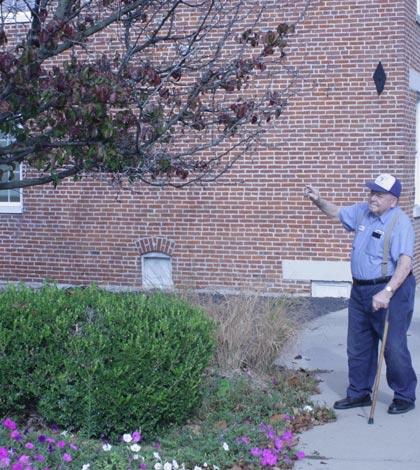What’s happening to area trees?

Bob Jones points to a dying tree on the courtyard next to the Monroe-Randolph Regional Office of Education in Waterloo. (Sean McGowan photo)
Bob Jones enjoys taking the occasional scenic route through the bluffs on the way back to his home in Waterloo from St. Louis.
There, the 86-year-old can admire the beauty of the significant forestry on either side of the road connecting Columbia to Valmeyer, as he has for years. But this year has been different due to weather and other circumstances.
“Everywhere you go, you see the trees are (in decline). Evergreen, Spruce, Pine, Oak — it doesn’t matter,” he said.
The pattern of leaves changing colors and falling from these trees may appear to follow the natural order that comes with the changing of the season. But for a good number of these trees, their leaves began dropping before the autumnal equinox.
Jones said he believes this phenomenon means many area trees are starting to die.
“You can see them. First they turn white, then yellowish, then as it goes, it turns brown,” he said. “You can see them up in town driving up and down streets.
“All over you can see them. It’s like people dying. You miss them. It happens so fast.”
Understanding Jones’ account, Joann Fricke of Clifftop said a number of factors come into play, though she believes the trees Jones described are struggling, but not yet dead.
“Some is likely drought and some might be herbicide drift — the same that you hear ads on the radio for class action suits for farmers who are losing crops, although other farmers are using the herbicide,” she said. “There is a great deal of concern about herbicide drift killing trees in the (Illinois Department of Natural Resources) community.
“Dicamba and 2,4-D are the culprits. I doubt the trees are dead, just stressed from drought. Although, if we have the same next year, they could die.
“We have a number of Oak trees dying on and near our property from Oak wilt. This travels through the root systems and there is virtually no way to stop it. It is just one of those things.”
Oak wilt is caused by a fungus spreading “through the water-conducting vessels of the sapwood. The tree’s response to the presence of the fungus results in the disruption of sap flow, and the affected areas wilt,” missouribotanicalgarden.org states.
Mark Brown, IDNR district forester for St. Clair, Monroe, Randolph and Perry counties, added that Oak wilt moves on trees under stress. He also said once the disease hits a Red Oak, it is likely to spread to the rest of the Red Oaks in a given area.
“That’s why I recommend you don’t prune them during the growing season. You need to wait until late fall or early winter,” he said.
Pruning can attract insects carrying the Oak wilt fungus. Another solution to preventing the spread of Oak wilt is severing the root grafts, which refers to where the roots of neighboring Oak trees are joined together under the soil.
Brown also confirmed what Fricke said about herbicide. He explained that Dicamba and 2,4-D are Phenoxy herbicides that can drift as vapor, spreading a great distance.
“(Herbicide) can drift a long way, maybe three to four miles down,” he said. “A lot of people want to blame their neighbor and that’s usually just not the case.”
Farmers use herbicides to kill unwanted plants that interfere with the growth of crops. However, unintended consequences of herbicides can include killing non-target plants.
The effects on trees can be seen with leaf browning or leaf loss. On the other hand, Brown said leaves drying up or turning brown can also indicate drought stress.
“Without examining the trees themselves, it’s hard to know more specifically what’s going on. I have three (Eastern redbuds) with leaves turning brown in my backyard. I have doubts that they’ll be coming back next year,” he said. “It is an extremely dry year.”
The United States Drought Monitor shows most of Monroe County experiencing a moderate drought. Such a level of dryness includes some damage to crops, pastures, streams and reservoirs. Brown said drought only serves as a catalyst in weakening trees.
“When you get into dry years, they fall more prey to insect disease,” he said, adding, “It’s usually not the drought that kills them.”
For instance, Brown noted that the Emerald ash borer — an exotic beetle whose larvae feed on the inner bark of ash trees and disrupt the tree’s ability to maintain water and nutrients — will soon reach the area.
The ash borer last made its way into the region in 2015.
Going back to the trees along the bluffs, Brown said these types of trees, such as Cottonwoods, need constant moisture and could be affected by drought. He added that excessive and continuous heat will cause trees to use moisture more rapidly to stay cool.
“The proof is going to be whether they leaf out next spring. That’s going to be the tell,” he said. “We need some moisture. They need precipitation in the winter to keep them going.”
Additionally, Brown suggested that anyone concerned with a particular tree they see struggling can water the tree. This is a process that involves watering the drip line from the trunk to the end of the branches to get to the roots.
“If you water the surface, you are probably never getting to the roots,” he said.






